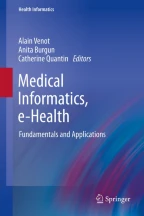
This chapter provides an introduction to the basic concepts of medical digital image processing. We kept the mathematical complexity of the chapter at a low level so that life science students can understand the underlying principles behind the methods of analysis and computer-assisted diagnosis.
After a brief description of the way in which the main medical image modalities are produced, the differences between image processing and image analysis are specified. Then the sampling and quantification processes, and their effects on image quality are explained. Grey level images and colour images are then introduced, as well as histogram-based image segmentation. The advantages and drawbacks of different lossy and lossless image compression techniques are given, and popular image formats are depicted, including the DICOM standard.
The principal image processing techniques are described: from pixel to pixel operations to spatial convolution techniques. Filtering in the frequency domain and mathematical morphology are rapidly described. So are shape recognition and classification, image registration and merging. Finally, Picture Archiving and Communication Systems (PACS) are briefly presented.
Throughout the chapter, examples are provided in order to ease the readers’ understanding.
This is a preview of subscription content, log in via an institution to check access.